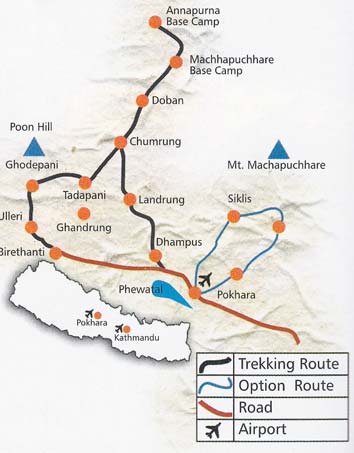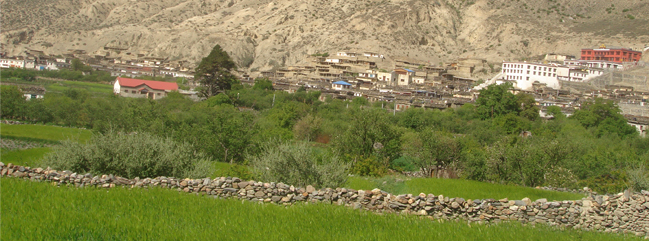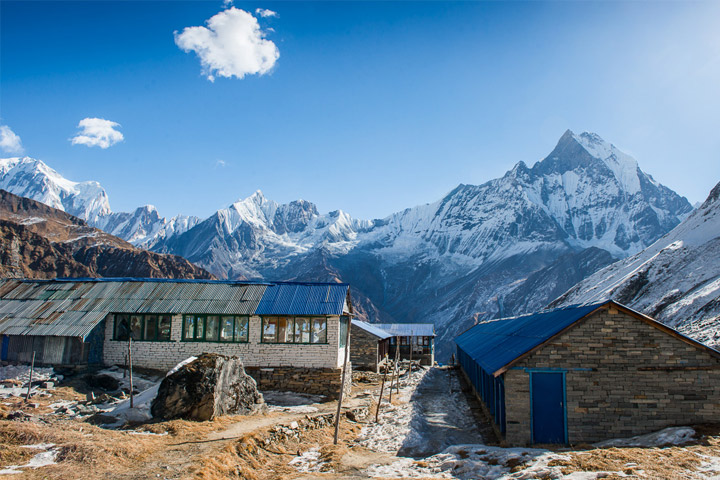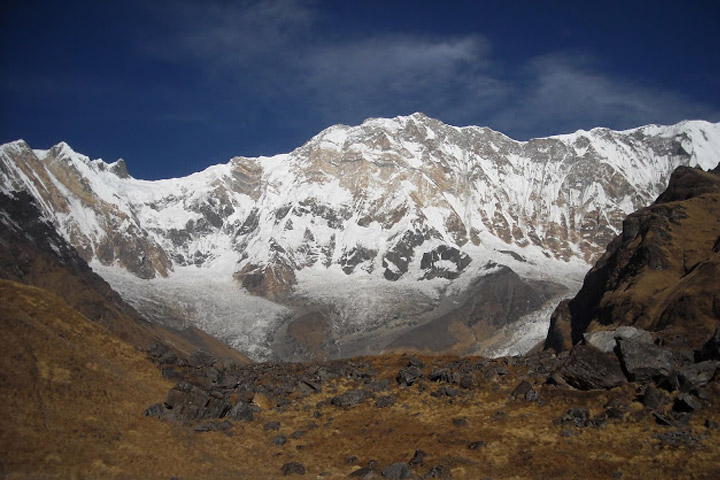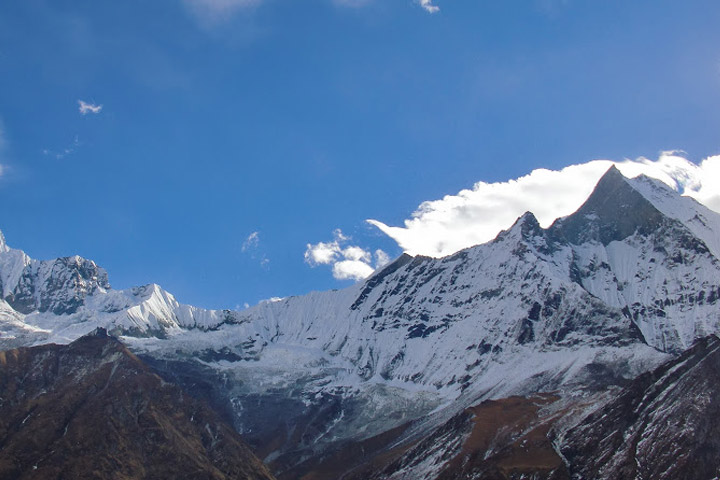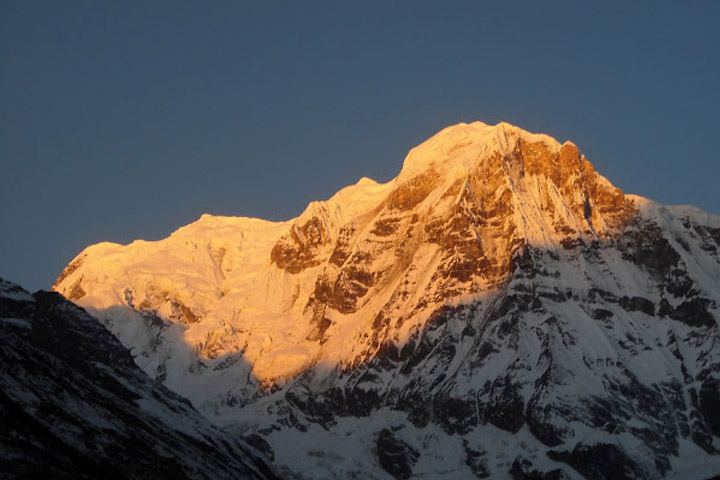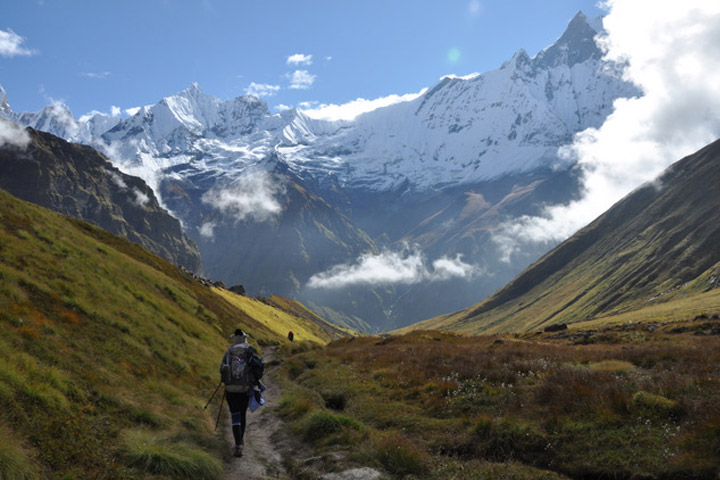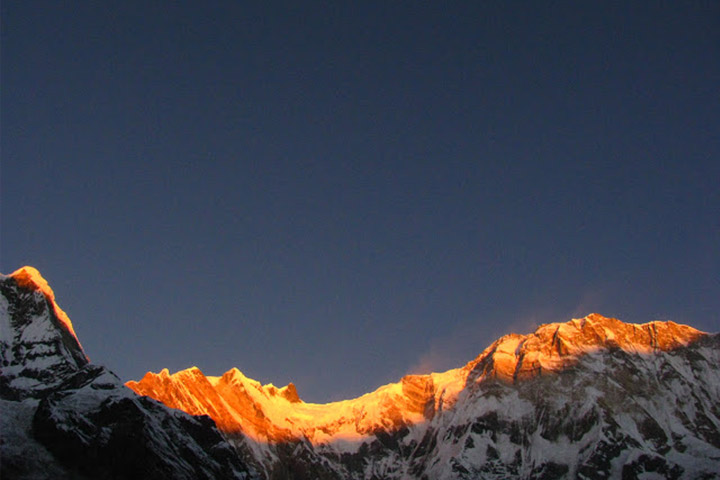The Annapurna Sanctuary / Base camp trek is a hike into the dazzling natural amphitheatre formed by the staggeringly beautiful peaks of the giants – Annapurna 1, Glacier Dome, Gangapurna, Fang and the fishtail peak of Machapuchare. Although there is only one entrance to the sanctuary itself, we follow locally known, lesser-used approaches and exit routes on our premier Annapurna Sanctuary Trek
The vast amphitheater of the Annapurna Sanctuary is encircled by the famous Himalayan peaks – the ‘fishtail’ spire of Machapuchare (6997m), Gangapurna (7454m), Annapurna 1 (8091m), the unclimbed Fang (7647m) and Annapurna South (7273m). The only approach follows the Modi Khola Valley through forests of oak, rhododendron and bamboo, passing through local Gurung villages to a world of soaring peaks.
Annapurna Sanctuary TrekkingThe flight from Kathmandu to Pokhara takes us past three 8000m giants . We start our Annapurna Sanctuary Trek with a short drive from Pokhara to Nayapul. We walk to a village by the Modi River, Birethanti(1000m). Walking through oak forest we cross several side valleys, which run into the Modi Khola, and climb a stone ‘staircase’ to the Gurung village of Chomrong (2060m). Trekking past Hinku cave, we reach what is known as the ‘gate’ into the Sanctuary – a pass between the spectacular peaks of Hiunchuli and Machapuchare.
The glaciated and snow covered peaks of the Sanctuary form a spectacular barrier .Dazzling views confront us as we trek up through the last permanent settlements to the Machapuchare Base Camp (3729m) where we are rewarded with superb views of ‘Fishtail’ mountain. While here we will also visit the Annapurna South Base camp.
Day 01 Kathmandu Arrival [1300m/4264ft]
Upon your arrival in the Kathmandu airport (KTM), you will be greeted by a representative from Himalayan Glacier Trekking. After completing your custom formalities (Visa, etc) pick up your luggage and look for our representative with a Himalayan Glacier Trekking display board at the arrival gate. You will be then transferred to Hotel Shanker or a similar category hotel. After check in, you can either take a rest, hang around in the city, visit our office; it all depends upon your interest. In the evening we will organize a Welcome Dinner at an excellent traditional Nepalese Restaurant where you will enjoy a Nepalese cultural program as well as a fine meal. Overnight in Kathmandu. Included meal:Dinner (D)
Day 02 Kathmandu: Sightseeing and Trek Preparation
Today after breakfast, we start a guided tour to several of the most historical and spiritual attractions in Kathmandu. Some of these landmarks are considered World Heritage Sites including the historic Durbar Square, the sacred Hindu temple of Pashupati Nath, the famous ‘Monkey Temple’ (Swayambhunath) and Buddhists shrine (Buddha Nath) which is one of the largest Stupas in the world. In the afternoon, there will be a pre-trip discussion where we can meet our trek leader and other team members. Himalayan Glacier Trekking briefs us regarding our trek as well as provides us opportunity to ask any questions we may have regarding our upcoming adventure. You might shop around the city if you need any gears for the trek during the evening time. Overnight in Kathmandu. Included meal: Breakfast (B)
Day 03 Kathmandu to Pokhara [823m/2,700ft]: 6 hrs drive
Early morning at around 7 am, we set off for Pokhara on a tourist bus. Enroute we will see more of countryside of Nepal that offers greeneries, rivers, villages, farms and beautiful mountain sceneries. Afternoon, we reach Pokhara. Pokhara offers magnificent views of Dhaulagiri, Manaslu, Machhapuchhare, five peaks of Annapurna and others. Pokhara is city of lakes and has numerous beautiful lakes. We can explore the most accessible and beautiful, Fewa Lake during the afternoon -enjoy boating too. Explore, relax and dine by tranquil Lake Fewa. We can even do some shopping during evening hours. Overnight in Pokhara. (B)
Day 04 Pokhara – Naya Pul-Ulleri [2050m/6725ft]: 1 hrs drive and 6 hours trek
Today we drive to Naya Pul to start our trek. From Naya Pul we follow the south bank of the river. After several hours we will pass through sub tropical valley forests, sometimes on the carved trail on the side of the cliff. After lunch, we cross the Modi Khola river via a suspension bridge to the village of Tikhedhunga. We trek further along the trail quite steep at times. We reach Ulleri by late afternoon for overnight. (B, L, D)
Day 05 Ulleri – Ghorepani (2750m/ 9020ft): 4-5 hrs trek
We make our ascent to the Ghorepani village. The name Ghorepani in Nepali means ‘horse-water’ owing to its role as an important campsite for traders before it became a trekker’s stop. Ghorepani is an interesting place with small shops and stalls for selling local products and craft. The town has two parts: one in a saddle and the other a few hundred feet lower. Since Ghorepani lies quite higher than our previous stop, we begin to feel the chilly weather especially in the evenings. Overnight in Ghorepani. (B, L, D)
Day 06 Ghorepani – Poon Hill – Tadapani (2700m/8,860ft): 5-6 hrs trek
Today is a special day because we conquer Poon Hill- an icon of Annapurna region. We climb the steep trail to the viewpoint of Poon Hill (3200mtrs). The efforts will be rewarded with spectacular views of Machhapuchre, Dhaulagiri, Nilgiri, and the Annapurnas. After taking photos and having some coffee, tea or hot chocolate, we return back to Gorepani. After breakfast, we head east and climb a nearby ridge. We descend through rhododendron forest, pass by spectacular waterfalls along the way and reach Tadapani for overnight.(B, L, D)
Day 07 Tadapani to Chhomrong (2170m/7120ft): 6 hrs trek
From Tadapani, we make a steep descent through the dense and dark forest. The route passes through the west bank of the Modi Khola. Then we descent steeply down the village of Chuile coming over to the Kimrong Khola. Then a steep climb continuing up to Chhomrong. Towering above the village is the mighty peak of Annapurna South, with the Fishtail Mountain (Machhapuchhare) facing it across the valley. Chhomrong is a beautiful village located on the lap of giant Annapurna massive. Overnight in Chhomrong. (B, L, D)
Day 08 Chhomrong to Dovan (2580m/8460ft): 6 hrs trek
We head out of Chhomrong along the Modi Khola leaving behind inhabited foothills into the high step and wooded slopes of Himalayas. We cross the suspension bridge then trek up to Sinuwa Danda. The ascent from Sinuwa becomes somewhat flatter. The trail passes through thick & dark rhododendron forest up to Khuldighar. Then the track passes through deep bamboo and rhododendron forest to the village of Dovan. (B, L, D)
Day 09 Dovan to Deurali (3230m/10,595ft): 4 hrs trek
The day starts with gentle gradual ascend following the trail above the river through a thick bamboo, oak and rhododendron forests up the side of the canyon. We cross two streams over small bridges. The trail passes through solitary places. The nature’s wilderness gives piece to our mind. There is also the possibility of seeing a variety of species of wildlife such as wild pig, deer, snow leopard, etc. Overnight in Deurali. (B, L, D)
Day 10 Deurali to MBC (3700m/12135ft): 3-4 hrs trek
Today we start our trek to Machhapuchre Base Camp (MBC). The trail climbs gently through a river bed and then it rises steeply over the mountain side. There are also avalanche prone areas at some point on the trail. After about half an hour’s walk from Deurali, we will find ourselves in middle of river bed surrounded by giant snow-covered mountains. When the sun rises, the snow on mountains shine and river valley is filled with warm sun rays. The hike to MBC is somewhat strenuous but the unfolding views of the majestic Machhapuchre are certainly a rewarding experience. Overnight in MBC. (B, L, D)
Day 11 MBC to ABC (4,130m/13,545ft): 2-3 hrs trek
On the way to ABC from MBC, the vegetation disappears. We’ll see the snow boulders melting and forming small streams. The path widens as we enter the Sanctuary, follows a stream, and then climbs to a few huts alongside a moraine. There are sensational views of the near-vertical south face of Annapurna towering above the sanctuary. Annapurna Base Camp sanctuary boasts of a dynamic view without anything impeding panorama of the 360 degrees. The Machhapuchre, Annapurna south, Annapurna I, Hiuchuli and other peaks. Climax of our trip almost ends today. Overnight in Annapurna Base Camp (4130m/13550ft). (B, L, D)
Day 12 ABC to Bamboo (2310m/7575ft): 6 hrs trek
We wake up at ABC and savor the magnificent sunrise over the Himalayas. Today, we start descending from ABC to MBC, Deurali, Dovan and finally to Bamboo. Heading back down to the valley is must easier than climbing up. Waterfalls cascading down the 500 foot granite faces on both sides to the forest below and great views of Fishtail and Hiuchuli are today’s attraction. Overnight in Bamboo. (B, L, D)
Day 13 Bamboo to Jhinu Dada (1760m/5770 ft): 6 hrs trek
From Bamboo we trek back to Sinuwa and then descend to Lower Chomrong. Then ascend on the thousand stony steps taking us to Upper Chomrong. From Chomrong we take a different route and instead of going to Ghandruk, we descend to Jhinu Danda. We get opportunity to enjoy hot springs lying just a 15-min walk from Jhinu Danda. Overnight in Jhinu Dada. (B, L, D)
Day 14 Jhinu Dada to Naya Pul to Pokhara: 6 hrs trek 1 hour drive
We trek from Jhinu danda to New bridge and then to Kyumi village. After lunch we trek to Sayali bazar and then down to Birethanti. From Birethanti, a half-an-hour’s trek takes us to Naya Pul. The trek ends at Naya Pul. From Naya Pul we take a vehicle and reach Pokhara in about an hour. We might take opportunity to visit some more places around Pokhara until evening. Overnight in Pokhara.(B, L)
Day 15 Fly Pokhara to Kathmandu: 30 minutes flight
Morning hours of today can be used very efficiently to visit some important spots around Pokhara city. Some places in Pokhara are really worth visiting. We might do some last hours shopping too. Around afternoon, we fly to Kathmandu. We catch left side of the airplane for the best views of Himalayas. Upon arrival in Kathmandu, we get transferred our hotel; and we spend the day leisurely, perhaps catch up on some last minute shopping or explore any sights you missed during your first day in Kathmandu and evening celebration dinner together. Stay overnight in Kathmandu. (B, D)
Day 16 Final Departure
Your adventure in Nepal comes to an end today! There is nothing to do but trade emails with travel companions and organize the photos. If you have more time you can do some shopping or sightseeing. A representative from Himalayan Glacier Trekking will take you to the airport approximately 3 hours before the scheduled flight. We say goodbye to you expecting you will again come to visit this wonderful country next time. (B)
Note: The above information is a guide and standard template of what we provide. The trek can be customized at your request to accommodate your specific requirements.
Note : On adventure trips of this type, weather, local politics, transport or a multitude of other factors beyond our control can result in a change of itinerary. It is, however, very unlikely that the itinerary would be substantially altered; if alterations are necessary the leader will decide what is the best alternative, taking into consideration the best interests of the whole group. Where a change does occur, we do everything we can to minimize its effect, but we cannot be responsible for the results of changes or delays.
Q.What type of shape do I need to be in, is this trip for me?
A. Trekking is suitable for average people who are moderately fit, thus no previous experience is required. Some physical fitness programs such as running, swimming, hiking is recommended before you embark on your journey. Persons suffering from a pre-existing medical condition or disease must seek medical advice before considering the trek. Whilst on the trek, it is common to experience some discomfort before being fully acclimatized.
To prepare for a strenuous trek you should begin training at least two to three months before your departure. As a guideline, an hour of aerobic exercise three to four times per week would be considered a minimum requirement. The best preparation is bushwalking involving relatively steep ascents and descents. If you can manage a couple of valley floor to ridgeline ascents per comfortable and able to enjoy the trek to the fullest. They are physically strong, sharp-witted and have an incredibly positive attitude towards a life that we would consider extremely tough. There is something about a trek in the Himalaya that draws you back time and time again. For keen walkers it is a paradise and even avowed non-walkers find that one foot just seems to follow the other, drawn by the appeal of what lies beyond.
Q. Will somebody come to pick me up at the Airport upon my arrival?
A. Yes, our Airport Representative will be there to greet you outside of Terminal Hall, he/she will be displaying an Kiwi Adventures Treks & Expedition sign board. Upon arrival, you will be transferred to your hotel.
Q. What sort of accommodation can I expect in Kathmandu and in trekking?
A. 11 night’s Trekking Guesthouse, 4 nights three/four star hotels in Kathmandu.
We use standard rooms from three/four star hotels in Kathmandu with breakfast included. Along the trekking routes teahouses/Lodges generally provide basic clean facilities with a mattress and a quilt or blanket. We can also offer you sleeping bags if needed (which need to return after the trip) but it is a good idea to always have your own sleeping equipment. We usually provide single and double rooms as well as the occasional dormitory. The dining room is downstairs around a fire. All food will be cooked to order in the little kitchen. You should not enter the kitchen unless asked to do so.
Q. What sort of food can I expect in trekking?
A. In trekking most teahouses (lodges) cook a delicious range of mostly vegetarian fare. Pasta, tuna bakes, noodles, potatoes, eggs, dhal bhat, bread, soups, fresh vegetables (variety depends on the season) and even some desserts like apple pies, pancakes, and some interesting attempts at custard. You will find a lot of garlic on the menu because it assists with acclimatization – eat some every day. In many larger villages you may find some meat on the menu. You can always get hot chocolate, tea, and hot lemon drinks, as well as soft drinks, and treats like chocolate and crisps.
Each day dinner and breakfast are used to take in the same lodge you spend the night. Lunch will be taken on the way to destination.
Q. What sort of transportation you use?
A. Kiwi Adventures Treks & Expedition is all about providing you with local insights as well as adventure, with that in mind, where we think you will get more out of your holiday by using different means of transport that is what we do. Using a variety of private transport is an integral part of our Himalaya tours and enhances the experience!
We use private tourist vehicles for sightseeing, city tours and pickups. Depending on the group size we use cars, minibus, van or land cruiser. These small light vehicles are more manoeuvrable and flexible enabling us to take you through the Narrow roads of Nepal. All the vehicles are usually air-conditioned unless we are travelling in cooler areas.
Q. What is the best season for this trekking?
A. Our trekking season extends from mid- September to May. From early September the monsoonal rains decrease. By end of September through to December the weather is usually stable with mild to warm days, cold nights. February, March, April, May, October, November, December are the best time to do trek.
Q. What is the weather & temperature like in trekking?
A. Weather in the mountains is notoriously difficult to predict. At night it is generally cooler the days are generally warm. Winter (January and February) will be bit colder but the days can be quite beautiful and warm if the sun is out. There will be bit of snow during the month of January, February and December. It is also important to make sure that you can stay warm and dry in just about any conditions. Expect the unexpected! The temperature could be as high as 20 deg C to -15 deg C low.
Q. Can I charge my digital camera or other batteries on my trip?
A. These facilities will be available in most of the places in your hotel reception by paying some service charges. Remember to bring your adapters!
Q. Is there any communication while we are on trekking?
A. There are telephones in some villages along the trekking routes from which you can make international calls.
Q. Can I use credit cards in the places visit in trekking?
A. In most cities yes, to some extent, however once you leave those cities behind, all you need is cash.
Q. How much additional money do I need per day?
A. In Kathmandu, you can allocate US$ 10 – 25 for a lunch / dinner. It’s all depends on your spending habits. US$7 to 10 US$ a day will be enough to buy bottles of water, chocolates and few drinks in trekking.
Q. Do I need to tip my guide and porters? How much would that be?
A. This is a difficult thing to gauge. We have seen everything from 20USD to 1000 USD per person for guides and porters. Tipping is not required, but a small way to show your guides and local porters thanks for their help. The level of the tip should reflect the level of personal involvement with your guide.
Q. Is the water OK to drink? Do I need to bring purifying tablets/filter?
A. In most places bottled water is readily available. If you wish to drink normal water, you need to use purifying aid, which you will need to bring with you.
Q. Are the Kiwi Adventures Treks & Expedition staff insured?
A. Our company insures all our trekking staff, including guide, cook, sherpa and porters.
Q. What essential documents do I need to bring with me on tour?
A. *Valid Passport – must be valid for up to 6 months after you return from your tour, keep a separate photocopy.
*Travel insurance, keep a separate photocopy
*Cash and Traveller’s Cheques, keep numbers and proof of purchase separate
*Flight tickets
*Emergency contact numbers for T/C’s, banks, insurance, family contacts.
Q. Can I add extra days to my trekking trip?
A. A hoilday should never be about making it to the final point quickly. Along your trek we can add days at your request with additional costs to cover guides, porters, accommodation and food.
Q. Do you use yaks/porters on the trek or do we carry all of our own gear?
A. Whilst on the trek, our porter will take care of your luggage. All you need to carry is your small day bag for your personal belongings like camera, water bottle, sun cream etc only.
Q. What opportunities will I have for shower along the trek?
A. In major places, we arrange guesthouse with hot shower. And in rest of the places, hotel water in bucket will be provided for shower; it would cost you extra about USD 3-4 per shower.
Q. Do you know about how many total miles the trek is?
A. Total distance of the entire trek is about 75 miles.
Cost Includes
• Airport / Hotel / Airport pick up & drop by private car / van / bus.
• Standard twin sharing accommodation in three/four star hotel in Kathmandu breakfast included. (3 nights)
• Standard twin sharing accommodation in two/three star hotel in Pokhara breakfast included. (3 nights)
• Guided city tour in Kathmandu and Pokhara by private car / van / bus.
• All your standard Meals during the trek.
• Twin sharing Lodges, Guesthouses accommodation during the trek (9 nights Trekking Guesthouse).
• Local Ace the Himalaya licensed English speaking Guide.
• The required number of local staff and Porters to carry your luggage during the trek.
• Food, accommodation, salary, insurance, equipment and medicine for all staff.
• Annapurna conservation Park permits.
• Surface transfer from and to Kathmandu.
• All our government taxes.
• Official expense.
Cost Excludes
• Lunch and dinner whilst in Kathmandu and Pokhara .
• Your travel insurance (compulsory, please contact us if you wish to sign up for the Global Rescue membership plan).
• International airfare and airport departure tax.
• Nepal entry visa, you can obtain a visa easily upon your arrival at Tribhuwan International Airport in Kathmandu. (Tourist Visa with Multiple Entry for 30 days can be obtained by paying US $ 40 or equivalent foreign currency. Similarly, Tourist Visa with Multiple Entry for 90 days can be obtained by paying US $ 100. You will also require 2 passport size photos.)
• Alcoholic, hot and cold drinks.
• Personal trekking Equipment.
• Tips for trekking staff. (Tipping is expected).
• Sightseeing/Monument entrance fees in Kathmandu and Pokhara.
• Any others expenses which are not mentioned on Price Includes section.
